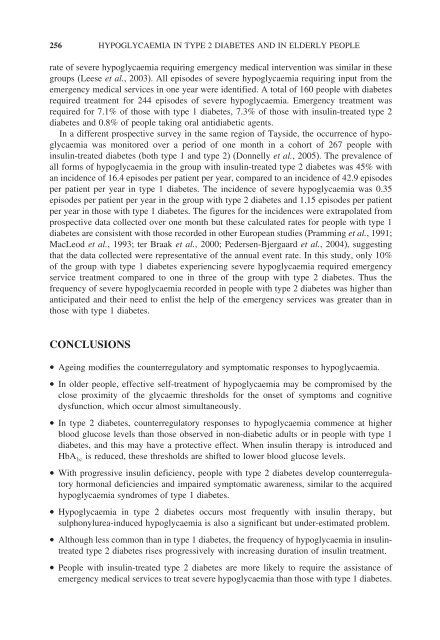Hypoglycaemia in Clinical Diabetes
Hypoglycaemia in Clinical Diabetes
Hypoglycaemia in Clinical Diabetes
- No tags were found...
You also want an ePaper? Increase the reach of your titles
YUMPU automatically turns print PDFs into web optimized ePapers that Google loves.
256 HYPOGLYCAEMIA IN TYPE 2 DIABETES AND IN ELDERLY PEOPLErate of severe hypoglycaemia requir<strong>in</strong>g emergency medical <strong>in</strong>tervention was similar <strong>in</strong> thesegroups (Leese et al., 2003). All episodes of severe hypoglycaemia requir<strong>in</strong>g <strong>in</strong>put from theemergency medical services <strong>in</strong> one year were identified. A total of 160 people with diabetesrequired treatment for 244 episodes of severe hypoglycaemia. Emergency treatment wasrequired for 7.1% of those with type 1 diabetes, 7.3% of those with <strong>in</strong>sul<strong>in</strong>-treated type 2diabetes and 0.8% of people tak<strong>in</strong>g oral antidiabetic agents.In a different prospective survey <strong>in</strong> the same region of Tayside, the occurrence of hypoglycaemiawas monitored over a period of one month <strong>in</strong> a cohort of 267 people with<strong>in</strong>sul<strong>in</strong>-treated diabetes (both type 1 and type 2) (Donnelly et al., 2005). The prevalence ofall forms of hypoglycaemia <strong>in</strong> the group with <strong>in</strong>sul<strong>in</strong>-treated type 2 diabetes was 45% withan <strong>in</strong>cidence of 16.4 episodes per patient per year, compared to an <strong>in</strong>cidence of 42.9 episodesper patient per year <strong>in</strong> type 1 diabetes. The <strong>in</strong>cidence of severe hypoglycaemia was 0.35episodes per patient per year <strong>in</strong> the group with type 2 diabetes and 1.15 episodes per patientper year <strong>in</strong> those with type 1 diabetes. The figures for the <strong>in</strong>cidences were extrapolated fromprospective data collected over one month but these calculated rates for people with type 1diabetes are consistent with those recorded <strong>in</strong> other European studies (Pramm<strong>in</strong>g et al., 1991;MacLeod et al., 1993; ter Braak et al., 2000; Pedersen-Bjergaard et al., 2004), suggest<strong>in</strong>gthat the data collected were representative of the annual event rate. In this study, only 10%of the group with type 1 diabetes experienc<strong>in</strong>g severe hypoglycaemia required emergencyservice treatment compared to one <strong>in</strong> three of the group with type 2 diabetes. Thus thefrequency of severe hypoglycaemia recorded <strong>in</strong> people with type 2 diabetes was higher thananticipated and their need to enlist the help of the emergency services was greater than <strong>in</strong>those with type 1 diabetes.CONCLUSIONS• Age<strong>in</strong>g modifies the counterregulatory and symptomatic responses to hypoglycaemia.• In older people, effective self-treatment of hypoglycaemia may be compromised by theclose proximity of the glycaemic thresholds for the onset of symptoms and cognitivedysfunction, which occur almost simultaneously.• In type 2 diabetes, counterregulatory responses to hypoglycaemia commence at higherblood glucose levels than those observed <strong>in</strong> non-diabetic adults or <strong>in</strong> people with type 1diabetes, and this may have a protective effect. When <strong>in</strong>sul<strong>in</strong> therapy is <strong>in</strong>troduced andHbA 1c is reduced, these thresholds are shifted to lower blood glucose levels.• With progressive <strong>in</strong>sul<strong>in</strong> deficiency, people with type 2 diabetes develop counterregulatoryhormonal deficiencies and impaired symptomatic awareness, similar to the acquiredhypoglycaemia syndromes of type 1 diabetes.• <strong>Hypoglycaemia</strong> <strong>in</strong> type 2 diabetes occurs most frequently with <strong>in</strong>sul<strong>in</strong> therapy, butsulphonylurea-<strong>in</strong>duced hypoglycaemia is also a significant but under-estimated problem.• Although less common than <strong>in</strong> type 1 diabetes, the frequency of hypoglycaemia <strong>in</strong> <strong>in</strong>sul<strong>in</strong>treatedtype 2 diabetes rises progressively with <strong>in</strong>creas<strong>in</strong>g duration of <strong>in</strong>sul<strong>in</strong> treatment.• People with <strong>in</strong>sul<strong>in</strong>-treated type 2 diabetes are more likely to require the assistance ofemergency medical services to treat severe hypoglycaemia than those with type 1 diabetes.
















